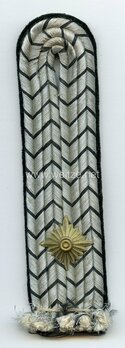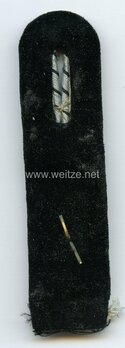RAD 2nd Pattern Oberfeldmeister Shoulder Boards
SKU: 80.GOR.03.02.01.02.008
Estimated market value:


Estimated market value:
Attributes
History
The RAD (Reichsarbeitsdienst = Reich Labour Service) was officially established on June 26, 1935 as the sole, and compulsory, labour service of Germany. Its purposes were to help the economy, curb unemployment, and indoctrinate its members with the NSDAP ideology, as well as play its part in militarising the German population.
The FAD (Freiwilliger Arbeitsdienst = Voluntary Labour Service) was the precursor of the RAD in the early 1930s. Official uniform regulations were first introduced on October 1, 1933, with modifications made in July 1934. It is also known as NSAD (Nationalsozialistischer Arbeitsdienst = National Socialist Labour Service).
The earliest uniforms were a not entirely successful attempt at standardisation. They gave way to a second wave of FAD uniforms that, when the RAD was established, experienced no significant changes.
The 1st pattern of RAD shoulder boards had originally been introduced for FAD members. With the establishment of the RAD, those shoulder boards were continued for a short period of time. They were worn by Officers only.
The 2nd pattern of shoulder boards was introduced in 1936. A 3rd pattern was introduced in 1942, which was in use until the end of the war. Both 2nd and 3rd pattern shoulder boards were worn by Officers as well as NCOs (Non-Commissioned Officers) and EMs (Enlisted Men).
Certain shoulder boards remained the same with a switch in patterns. FAD and RAD shoulder boards and shoulder straps were worn on both shoulders.
The underlays of the shoulder boards are in specific branch colours: members of the general branch wore a black underlay, the medical underlay colour was cornflower-blue, forest-green for administrative members, light blue for judicial members, and war correspondents wore a lemon-yellow underlay.
By a regulation introduced on July 6, 1934, Officers who had honourably retired received permission to retain their uniforms. They wore an underlay of corn poppy red (ponceaurot) cloth on the shoulder boards. A later regulation stated that retired officers instead were to wear a silver strip of braid sewn to the center of the black velvet underlay with the ends protruding at the sides.
Also as of July 6, Honorary Officers (Ehrenführer) wore an underlay in cavalry yellow, however, this was changed to white later in 1934.
With the introduction of the 2nd pattern, retired Officers wore the regular shoulder boards for their rank, but with a bit of silver Tresse (braid) with a zig-zag pattern underneath the shoulder boards, positioned in the middle and protruding on both sides.
During the later war years, EM and NCO volunteers wore two silver and black (later just silver-coloured) twist cord loops at the bottom of the shoulder boards to denote this status.
The rank of Arbeitsdienstinspekteur was renamed to Oberstarbeitsführer on July 20, 1934.
The Gauarbeitsführer (later Oberarbeitsführer) and Obertruppführer ranks were introduced on July 20, 1934.
The rank of Unterfeldmeister was initially an Officer rank in the FAD, but with the establishment of the RAD it became the highest NCO rank instead.
The lowest rank, Arbeitsmann, was initially known as Arbeitswilliger or Arbeitsfreiwilliger.
1st pattern shoulder boards were as follows:
Reichsarbeitsführer wore two straight double rows in silver with black chevrons and a golden border on each side, with three bends (two over one) at the bottom, and two transverse “slider” bars made of two cords each, in the same design.
Oberstarbeitsführer wore two straight double rows in silver with black chevrons and a golden border on each side, with three bends (two over one) at the bottom, and one transverse “slider” bar made of two cords, in the same design.
Oberarbeitsführer wore two straight double rows in silver with black chevrons, with three bends (two over one) at the bottom, and two transverse “slider” bars made of two cords each, in the same design.
Arbeitsführer wore two straight double rows in silver with black chevrons, with three bends (two over one) at the bottom, and one transverse “slider” bar made of two cords, in the same design.
Oberstfeldmeister wore two straight double rows in silver with black chevrons, with one bend on each side at the bottom, and two transverse “slider” bars made of two cords each, in the same design.
Oberfeldmeister wore two straight double rows in silver with black chevrons, with one bend on each side at the bottom, and one transverse “slider” bar made of two cords, in the same design.
Feldmeister wore two straight double rows in silver with black chevrons, and two transverse “slider” bars made of two cords each, in the same design.
Unterfeldmeister wore two straight double rows in silver with black chevrons, and one transverse “slider” bar made of two cords, in the same design.
Ranks Obertruppführer, Truppführer, Obervormann, Vormann, and Arbeitsmann did not wear shoulder boards.
Musikzugführer (band leaders) wore the same shoulder boards as Unterfeldmeister, except in red rather than in silver.
Rank pips used for some of the shoulder boards of the 2nd pattern are made of metal and in the shape of a four-sided star.
2nd pattern shoulder boards were as follows:
Reichsarbeitsführer wore triple cords made up of a silver cord with a black chevron pattern in the centre, with a gold-coloured cord on each side, all intertwined to form four bends and a button loop, and with two silver-coloured rank pips. The underlay was in black.
Obergeneralarbeitsführer wore triple cords made up of a silver cord with a black chevron pattern in the centre, with a gold-coloured cord on each side, all intertwined to form four bends and a button loop, and with a silver-coloured rank pip. The underlay was in black.
Generalarbeitsführer wore triple cords made up of a silver cord with a black chevron pattern in the centre, with a gold-coloured cord on each side, all intertwined to form four bends and a button loop. The underlay was in black.
Oberstarbeitsführer wore double-laid double cords in silver with a pattern of black chevrons, intertwined to form five bends and a button loop, as well as two gold-coloured rank pips. The underlay was in branch colour.
Oberarbeitsführer wore double-laid double cords in silver with a pattern of black chevrons, intertwined to form five bends and a button loop, as well as one gold-coloured rank pip. The underlay was in branch colour.
Arbeitsführer wore double-laid double cords in silver with a pattern of black chevrons, intertwined to form five bends and a button loop. The underlay was in branch colour.
Oberstfeldmeister wore two double-laid double cords in silver with a pattern of black chevrons and two gold-coloured rank pips. The underlay was in branch colour.
Oberfeldmeister wore two double-laid double cords in silver with a pattern of black chevrons and one gold-coloured rank pip. The underlay was in branch colour.
Feldmeister wore two double-laid double cords in silver with a pattern of black chevrons. The underlay was in branch colour.
Unterfeldmeister wore a double-laid brown double cord framed by an outer double cord in silver with a pattern of black chevrons. The underlay was in branch colour.
Obertruppführer wore brown shoulder straps with branch colour piping and a border of aluminum Tresse (braids) with a black centre stripe around the entire strap, as well as an additional silver-coloured rank pip.
Truppführer wore brown shoulder straps with branch colour piping and a border of aluminum Tresse with a black centre stripe. The border does not extend across the bottom of the straps.
Enlisted ranks members, including Obervormann, Vormann, and Arbeitsmann, wore brown shoulder straps with alternating black and silver twist cord piping. Members in the rank of Arbeitsmann only wore shoulder straps if they volunteered for at least one year.
Obermusikzugführer (senior band leaders) wore an outer red double-cord and an inner red/silver/red triple cord, the latter of which being intertwined to form six bends, and with one silver rank pip. The underlay was in black.
Musikzugführer (band leaders) wore an outer red double-cord and an inner red/silver/red triple cord, the latter of which being intertwined to form six bends. The underlay was in black.
RAD leaders in the annexed regions of Austria and the Sudetenland wore special shoulder boards that were introduced on July 15, 1938. They are much slimmer than the regular RAD shoulder boards and the underlay for all was black.
Oberstarbeitsführer to Arbeitsführer ranks wore a silver-coloured double cord intertwined to form nine or ten bends and a button loop.
Oberstfeldmeister to Feldmeister ranks wore a double-laid silver-coloured double cord.
Obertruppführer and Truppführer ranks wore a double-laid double cord with a pattern of alternating silver-coloured and black chevrons.
3rd pattern shoulder boards were as follows:
Reichsarbeitsführer wore triple cords made up of a silver cord with a black chevron pattern in the centre, with a gold-coloured cord on each side, all intertwined to form four bends and a button loop. On top was a silver metal device in the form of an eagle with outstretched wings sitting on an oak leaf/laurel wreath, inside of which was an upwards pointing shovel framed by an ear of wheat on each side, with a swastika on the blade. The underlay was in black.
Generaloberstfeldmeister wore triple cords made up of a silver cord with a black chevron pattern in the centre, with a gold-coloured cord on each side, all intertwined to form four bends and a button loop, and with three silver-coloured rank pips, one over two. The underlay was in black.
Generalfeldmeister wore triple cords made up of a silver cord with a black chevron pattern in the centre, with a gold-coloured cord on each side, all intertwined to form four bends and a button loop, and with two silver-coloured rank pips. The underlay was in black.
Obergeneralarbeitsführer wore triple cords made up of a silver cord with a black chevron pattern in the centre, with a gold-coloured cord on each side, all intertwined to form four bends and a button loop, and with a silver-coloured rank pip. The underlay was in black. This shoulder board remained unchanged from the 2nd pattern.
Generalarbeitsführer wore triple cords made up of a silver cord with a black chevron pattern in the centre, with a gold-coloured cord on each side, all intertwined to form four bends and a button loop. The underlay was in black. This shoulder board remained unchanged from the 2nd pattern.
Oberstarbeitsführer wore double-laid double cords in silver with a pattern of black chevrons, intertwined to form five bends and a button loop, as well as two gold-coloured rank pips. The underlay was in branch colour. This shoulder board remained unchanged from the 2nd pattern.
Oberarbeitsführer wore double-laid double cords in silver with a pattern of black chevrons, intertwined to form five bends and a button loop, as well as one gold-coloured rank pip. The underlay was in branch colour. This shoulder board remained unchanged from the 2nd pattern.
Arbeitsführer wore double-laid double cords in silver with a pattern of black chevrons, intertwined to form five bends and a button loop. The underlay was in branch colour. This shoulder board remained unchanged from the 2nd pattern.
Oberstfeldmeister wore two double-laid double cords in silver with a pattern of black chevrons and two gold-coloured rank pips. The underlay was in branch colour. This shoulder board remained unchanged from the 2nd pattern.
Oberfeldmeister wore two double-laid double cords in silver with a pattern of black chevrons and one gold-coloured rank pip. The underlay was in branch colour. This shoulder board remained unchanged from the 2nd pattern.
Feldmeister wore two double-laid double cords in silver with a pattern of black chevrons. The underlay was in branch colour. This shoulder board remained unchanged from the 2nd pattern.
Unterfeldmeister wore a double-laid brown double cord with a pattern of silver chevrons framed by an outer double cord in silver with a pattern of black chevrons. The underlay was in branch colour.
Haupttruppführer wore brown shoulder straps with black piping and a border of silver-coloured Tresse (braids) with a zig-zag pattern around the outer edge, including the bottom, as well as one rank pip. This rank was introduced in May of 1944. The shoulder straps are identical to those worn by Obertruppführer.
Obertruppführer wore brown shoulder straps with black piping and a border of silver-coloured Tresse around the outer edge, including the bottom, as well as one rank pip. The shoulder straps are identical to those worn by Haupttruppführer.
Truppführer wore brown shoulder straps with black piping and a border of silver-coloured Tresse around the outer edge, but not at the bottom.
Untertruppführer wore brown shoulder straps with silver twist cord piping, as well as two rank pip and silver-coloured Tresse at the bottom.
Members in the rank of Hauptvormann wore brown shoulder straps with silver twist cord piping, as well as two rank pip.
Members in the rank of Obervormann wore brown shoulder straps with silver twist cord piping, as well as one rank pip.
Members in the rank of Vormann wore brown shoulder straps with silver twist cord piping.
Members in the rank of Arbeitsmann only wore shoulder straps if they were volunteers. The shoulder straps are brown with black piping, with two twist cords in alternating black and silver (later just silver) looped around the bottom.


Comments
Sign in to comment and reply.


Scroll Top